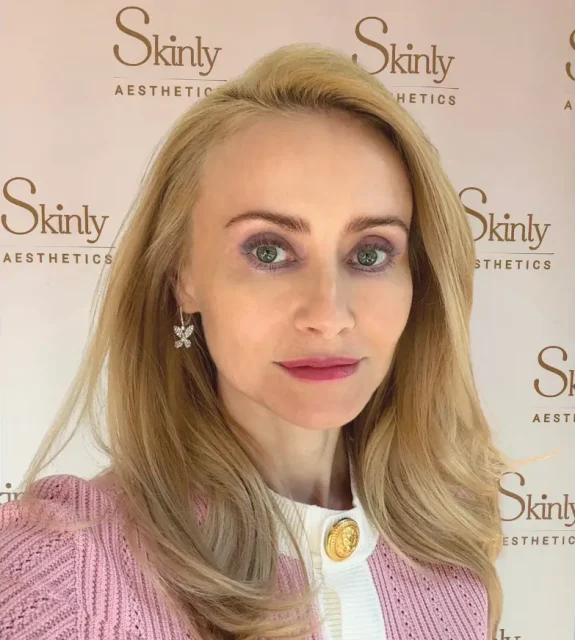Gynecomastia and pseudogynecomastia are conditions characterized by the enlargement of male breast tissue, yet they differ in their underlying causes and the nature of the tissue involved. Haute Beauty Ambassador Dr. Sachin Shridharani of LUXURGERY shares his insights on these conditions, covering causes, visual distinctions, and treatment options. Understanding these differences helps individuals seek appropriate treatments and make informed health decisions.
 Photo Credit: Courtesy of Volles/Shutterstock
Photo Credit: Courtesy of Volles/Shutterstock
Primary Causes
Gynecomastia: This condition involves the enlargement of glandular breast tissue and is primarily driven by hormonal imbalances. Factors contributing to gynecomastia include:
- Hormonal Imbalances: An imbalance between estrogen and testosterone levels can lead to glandular tissue growth in the male breast.
- Puberty: Hormonal fluctuations during puberty can result in temporary gynecomastia.
- Aging: As men age, changes in hormone levels can cause breast tissue enlargement.
- Medications: Certain medications, including some used for treating prostate cancer, heart conditions, and mental health issues, can contribute to gynecomastia.
- Health Conditions: Underlying health issues such as liver or kidney disease, hyperthyroidism, and tumors can also cause gynecomastia.
Pseudogynecomastia: Unlike gynecomastia, pseudogynecomastia involves fat accumulation in the chest area without an increase in glandular tissue. Key causes include:
- Weight Gain: Excessive fat accumulation in the chest area is often due to weight gain.
- Lifestyle Factors: Poor diet, lack of exercise, and excessive consumption of alcohol or drugs can lead to the development of pseudogynecomastia.
Distinguishing Between Gynecomastia and Pseudogynecomastia
Visually distinguishing between gynecomastia and pseudogynecomastia can be challenging, but there are some key differences:
- Gynecomastia: Typically, there is a noticeable enlargement of the nipple and areola area due to underlying glandular tissue. The texture of the enlarged area may feel firmer compared to the surrounding chest tissue. Gynecomastia often affects both breasts symmetrically, though it can occasionally be unilateral.
- Pseudogynecomastia: The nipple and areola may not significantly enlarge or change shape. The fat distribution is more irregular and uneven, following typical patterns of body fat. The affected chest area feels softer, resembling fatty tissue more than glandular tissue.
Hormonal Imbalance and Gynecomastia
Hormonal imbalance plays a significant role in the development of gynecomastia. Normally, men have higher levels of testosterone compared to estrogen. When this balance is disrupted, and estrogen levels rise or testosterone levels fall, glandular breast tissue may grow. This imbalance can be caused by various factors, including health conditions, medications, and natural hormonal changes during puberty or aging.
View this post on Instagram
Influence of Lifestyle Factors on Pseudogynecomastia
Lifestyle choices significantly impact the development and appearance of pseudogynecomastia. Factors include:
- Diet: Reducing overall caloric intake and maintaining a balanced diet with appropriate levels of proteins, fats, and carbohydrates can help manage weight and reduce fat accumulation in the chest area.
- Exercise: Engaging in regular physical activities like running, swimming, cycling, or brisk walking can help burn calories and reduce body fat, including chest fat. Strength training exercises like bench presses and push-ups can improve chest appearance by increasing muscle mass and reducing fat.
Common Misconceptions
There are several misconceptions about gynecomastia and pseudogynecomastia:
- Interchangeability: Many believe these conditions are the same, but they have different causes and tissue involvement.
- Obesity: It is commonly thought that only obese men are affected, but gynecomastia can occur in men of any weight.
- Treatment: There is a misconception that surgery is the only treatment option, whereas non-surgical treatments are also available.
- Early Treatment: Some believe gynecomastia must be treated immediately in adolescence, but in many cases, it resolves on its own.
Treatment Options
Treatment for gynecomastia and pseudogynecomastia includes both surgical and non-surgical options:
- Gynecomastia: Treatments range from advanced liposuction techniques to glandular excision through incisions around the areola. In severe cases, full chest reduction surgery may be necessary.
- Pseudogynecomastia: Non-surgical treatments like Kybella (deoxycholic acid) injections can reduce fat. Surgical options include liposuction to remove excess fat.
Understanding the distinctions between gynecomastia and pseudogynecomastia, their causes, and treatment options helps in making informed decisions about managing these conditions effectively.
For more information, visit Sachin Shridharani, MD, FACS's social media:





















